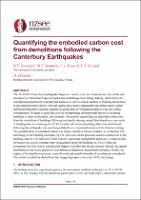| dc.contributor.author | Gonzalez Espinel, Rosa Eva | |
| dc.contributor.author | Stephens, Max | |
| dc.contributor.author | Toma, Charlotte | |
| dc.contributor.author | Elwood, Ken | |
| dc.contributor.author | Dowdell, David | |
| dc.date.accessioned | 2021-06-22T04:02:08Z | |
| dc.date.available | 2021-06-22T04:02:08Z | |
| dc.date.issued | 2021-04-14 | |
| dc.identifier.uri | https://repo.nzsee.org.nz/xmlui/handle/nzsee/2436 | |
| dc.description.abstract | The 2010/2011 Canterbury Earthquake Sequence resulted in severe financial loss, loss of life and disruption in Christchurch due to liquefaction and damage from strong shaking, which led to the widespread displacement of people and business as well as a large number of building demolitions in the central business district. Several studies have since evaluated the prevailing factors which influenced demolition decision making, revealing that environmental impacts were not a direct consideration. To begin to make the case for incorporating environmental factors in designing buildings to resist earthquakes, this research is focused on identifying the environmental costs of demolishing buildings following earthquake damage using Christchurch as a case study. A building data set consisting of 142 RC (reinforced concrete) buildings that were demolished following the earthquake was used to quantify the environmental impacts of the decision making. The environmental impacts were broken into three distinct modules, (1) embodied CO2 and energy in the building materials, (2) impacts of the processes used in construction of the building, and (3) impacts of the transport and waste management processes. A material take-off model was used to estimate material quantities across the building set. First, a lifecycle assessment tool was used to calculate the impact on the first and second module. Second, the spatial distribution of the waste generation was defined to determine transportation distance. Finally, the impact of the demolition process, waste disposal and possible benefits of recycling are considered. The results revealed the demolitions had staggering impacts in terms of CO2 and energy. | |
| dc.language.iso | en | |
| dc.publisher | New Zealand Society for Earthquake Engineering | |
| dc.relation.ispartofseries | 2021;0048 | |
| dc.subject | Resilience beyond life-safety and amenity | |
| dc.subject | Innovative approaches in seismic design and assessment | |
| dc.title | Quantifying the Embodied Carbon Cost from Demolitions Following the Canterbury Earthquakes | |
| dc.type | Article | |

